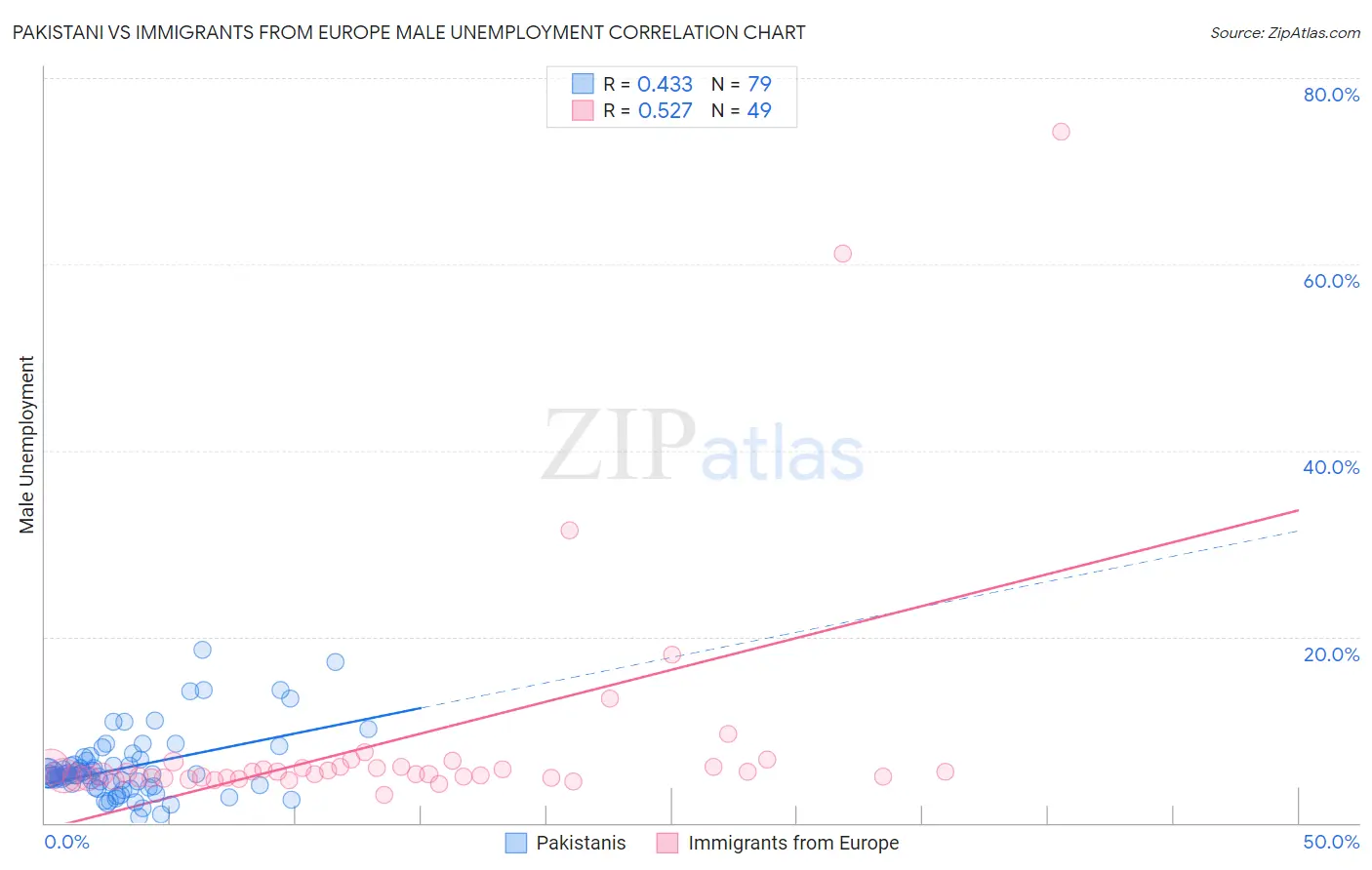Pakistani vs Immigrants from Europe Male Unemployment
COMPARE
Pakistani
Immigrants from Europe
Male Unemployment
Male Unemployment Comparison
Pakistanis
Immigrants from Europe
5.2%
MALE UNEMPLOYMENT
80.5/ 100
METRIC RATING
134th/ 347
METRIC RANK
5.2%
MALE UNEMPLOYMENT
76.2/ 100
METRIC RATING
149th/ 347
METRIC RANK
Pakistani vs Immigrants from Europe Male Unemployment Correlation Chart
The statistical analysis conducted on geographies consisting of 334,491,221 people shows a moderate positive correlation between the proportion of Pakistanis and unemployment rate among males in the United States with a correlation coefficient (R) of 0.433 and weighted average of 5.2%. Similarly, the statistical analysis conducted on geographies consisting of 540,308,967 people shows a substantial positive correlation between the proportion of Immigrants from Europe and unemployment rate among males in the United States with a correlation coefficient (R) of 0.527 and weighted average of 5.2%, a difference of 0.37%.

Male Unemployment Correlation Summary
| Measurement | Pakistani | Immigrants from Europe |
| Minimum | 0.60% | 3.1% |
| Maximum | 18.6% | 74.2% |
| Range | 18.0% | 71.1% |
| Mean | 5.9% | 8.9% |
| Median | 5.1% | 5.3% |
| Interquartile 25% (IQ1) | 3.9% | 4.8% |
| Interquartile 75% (IQ3) | 6.6% | 6.0% |
| Interquartile Range (IQR) | 2.7% | 1.2% |
| Standard Deviation (Sample) | 3.5% | 13.0% |
| Standard Deviation (Population) | 3.5% | 12.9% |
Demographics Similar to Pakistanis and Immigrants from Europe by Male Unemployment
In terms of male unemployment, the demographic groups most similar to Pakistanis are Immigrants from Saudi Arabia (5.2%, a difference of 0.030%), Lebanese (5.2%, a difference of 0.050%), Colombian (5.2%, a difference of 0.060%), Immigrants from Eastern Africa (5.2%, a difference of 0.060%), and Immigrants from Croatia (5.2%, a difference of 0.070%). Similarly, the demographic groups most similar to Immigrants from Europe are Immigrants from Italy (5.2%, a difference of 0.010%), Indian (Asian) (5.2%, a difference of 0.020%), Slovak (5.2%, a difference of 0.060%), Immigrants from Burma/Myanmar (5.2%, a difference of 0.11%), and Macedonian (5.2%, a difference of 0.12%).
| Demographics | Rating | Rank | Male Unemployment |
| Immigrants | Germany | 83.0 /100 | #131 | Excellent 5.2% |
| Chickasaw | 82.9 /100 | #132 | Excellent 5.2% |
| Colombians | 81.1 /100 | #133 | Excellent 5.2% |
| Pakistanis | 80.5 /100 | #134 | Excellent 5.2% |
| Immigrants | Saudi Arabia | 80.1 /100 | #135 | Excellent 5.2% |
| Lebanese | 79.9 /100 | #136 | Good 5.2% |
| Immigrants | Eastern Africa | 79.8 /100 | #137 | Good 5.2% |
| Immigrants | Croatia | 79.7 /100 | #138 | Good 5.2% |
| Kenyans | 79.4 /100 | #139 | Good 5.2% |
| Brazilians | 79.3 /100 | #140 | Good 5.2% |
| Immigrants | Switzerland | 79.2 /100 | #141 | Good 5.2% |
| Fijians | 78.3 /100 | #142 | Good 5.2% |
| Syrians | 78.0 /100 | #143 | Good 5.2% |
| Sri Lankans | 77.9 /100 | #144 | Good 5.2% |
| Macedonians | 77.7 /100 | #145 | Good 5.2% |
| Immigrants | Kenya | 77.6 /100 | #146 | Good 5.2% |
| Immigrants | Burma/Myanmar | 77.5 /100 | #147 | Good 5.2% |
| Immigrants | Italy | 76.3 /100 | #148 | Good 5.2% |
| Immigrants | Europe | 76.2 /100 | #149 | Good 5.2% |
| Indians (Asian) | 76.0 /100 | #150 | Good 5.2% |
| Slovaks | 75.5 /100 | #151 | Good 5.2% |